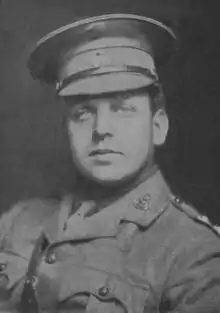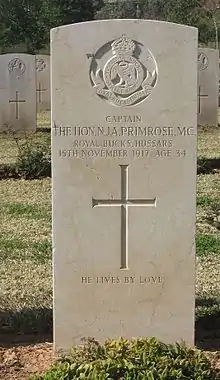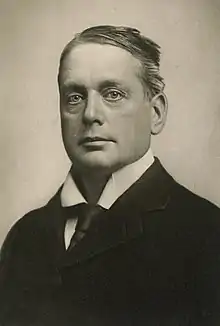Neil Primrose (politician)
Neil James Archibald Primrose MC PC (14 December 1882 – 15 November 1917) was a British Liberal politician and soldier. The second son of Prime Minister Lord Rosebery, he represented Wisbech in parliament from 1910 to 1917 and served as Under-Secretary of State for Foreign Affairs in 1915 and as joint-Parliamentary Secretary to the Treasury from 1916 to 1917. He died from wounds received in action in Palestine in 1917.
Neil Primrose | |
|---|---|
 Neil Primrose | |
| Parliamentary Secretary to the Treasury with Lord Edmund Talbot | |
| In office 14 December 1916 – 2 March 1917 | |
| Monarch | George V |
| Prime Minister | David Lloyd George |
| Preceded by | Lord Edmund Talbot John Gulland |
| Succeeded by | Lord Edmund Talbot Hon. Frederick Guest |
| Personal details | |
| Born | 14 December 1882 Dalmeny House, Dalmeny, Midlothian |
| Died | 15 November 1917 (aged 34) Gezer, Palestine |
| Resting place | Ramleh Commonwealth War Graves Commission Cemetery |
| Nationality | British |
| Political party | Liberal |
| Spouse(s) | Lady Victoria Stanley (1892–1927) |
| Children | Ruth Wood, Countess of Halifax |
| Parent(s) | Archibald Primrose, 5th Earl of Rosebery Hannah de Rothschild |
| Awards | Military Cross |
| Military service | |
| Allegiance | |
| Branch/service | British Army |
| Years of service | 1909–1917 |
| Rank | Captain |
| Unit | Royal Buckinghamshire Hussars |
| Battles/wars | First World War |
Background
Primrose was born at Dalmeny House in Midlothian, Scotland, the second son of Archibald Primrose, 5th Earl of Rosebery, Prime Minister to Queen Victoria from 1894 to 1895, and Hannah de Rothschild, daughter of Baron Mayer de Rothschild. He was the brother of Harry Primrose, 6th Earl of Rosebery and writer Lady Sybil Grant.[1] He was educated at Eton and Oxford and played No.1 for the Oxford Polo team in 1904 and 1905.[2] While at Oxford he was also a keen steeplechase rider.[3]
Political career
Primrose entered the House of Commons at the January 1910 general election as Member of Parliament (MP) for Wisbech.[4][5] In 1913 he became a member of the Anglo-American Peace Centenary Committee.[6] In February 1915 he was appointed Under-Secretary of State for Foreign Affairs in H. H. Asquith's Liberal administration, but was not offered a post when the coalition government was formed in May of the same year. When David Lloyd George became prime minister in December 1916, Primrose returned to the government as joint-Parliamentary Secretary to the Treasury (government chief whip) alongside Conservative Lord Edmund Talbot, a post he only held until March of the following year. In June 1917 he was sworn of the Privy Council.[7]
Military career

Primrose was commissioned into the Buckinghamshire Yeomanry (Royal Bucks Hussars) in 1909.[8] Promoted Captain in 1915, he was awarded the Military Cross in the King's Birthday Honours of June 1916.[9] He died in November 1917 from wounds received in action at Gezer during the Sinai and Palestine Campaign while leading his squadron of the 1/1st Royal Buckinghamshire Yeomanry against Turkish positions on the Abu Shusheh ridge during the Third Battle of Gaza.
Commemoration
When news of the death of Primrose reached the UK, Prime Minister David Lloyd George paid tribute in the House of Commons on 19 November 1917, alongside his report of the death of Lieutenant General Sir Frederick Stanley Maude:
May I be permitted before I sit down to utter one word of another who held an inconspicuous position in the Army but who was well known to all Members of this House. I refer to Captain Neil Primrose. The House knew his bright and radiant spirit well. To his intimates he was one of the most lovable men we ever met. He had ability far above the average, and, in spite of the reserve and shyness which held him back, his future was full of hope. He had already rendered distinguished service in the field, and for that service he had been recognised at the suggestion of his commanding officer; and he might well, for he had many offers, have occupied positions where he could have rendered services to the public, positions honourable to him, but positions of personal safety, and the fact that he had been chosen by his constituents to serve in this House would have rendered his acceptance of these positions honourable to himself. He chose deliberately the path of danger. He fell charging at the head of his troops, at the very moment of victory, and Members of the House will, I feel certain, join me in an expression of deepest sympathy with those whom he has left behind to mourn him.
— David Lloyd George, House of Commons parliamentary debate, 19 November 1917[10]

Responding to the Prime Minister, the former Prime Minister H. H. Asquith (who had himself lost a son in 1916) referred to "two very great national losses" and also paid his respects:
In regard to the other loss to which my right hon. Friend has referred, and which more particularly affects this House, a more familiar and well-loved face has passed from among us, and I only trust myself to say this, that there are few who can realise better than myself how much of hope and of promise there was for his future, and I am sure that his distinguished father and family will have the heartfelt sympathy of every Member of this House.
— H. H. Asquith, House of Commons parliamentary debate, 19 November 1917[11]
Primrose is buried in the Ramleh Commonwealth War Graves Commission Cemetery at Ramla, in Israel.[12][13] The inscription on his gravestone reads: HE LIVES BY LOVE.[12] Primrose is commemorated on Panel 8 of the Parliamentary War Memorial in Westminster Hall, one of 22 MPs that died during World War I to be named on that memorial.[14][15] Primrose is one of 19 MPs who fell in the war who are commemorated by heraldic shields in the Commons Chamber.[16] A further act of commemoration came with the unveiling in 1932 of a manuscript-style illuminated book of remembrance for the House of Commons, which includes a short biographical account of the life and death of Primrose.[17][18] Memorial tablets were erected by his father in St Giles' Cathedral, Edinburgh, in the Church of St Mary the Virgin, Mentmore, Buckinghamshire, and at Christ Church, Epsom Common, Surrey. Additional memorials were erected to his memory in the form of a stained glass window in St Mary's Church, Knowsley, Merseyside, by his widow's parents,[19][T 1] and a further plaque was erected by his father in All Saints Church, Postwick, Norfolk.[20][T 2]
- Memorials erected to the memory of Neil Primrose by his father

 Christ Church, Epsom Common[T 4]
Christ Church, Epsom Common[T 4]_(geograph_2601688).jpg.webp)
Family
Primrose married Lady Victoria Stanley, daughter of Edward Stanley, 17th Earl of Derby, on 7 April 1915.[21] They had one daughter: Ruth Alice Hannah Mary Primrose (18 April 1916 – 1989), who married Charles Wood, 2nd Earl of Halifax, on 25 April 1936.
Lady Victoria married as her second husband Malcolm Bullock, and had one daughter, Priscilla, by him. Lady Victoria died in a hunting accident in November 1927.[1]
Notes and references
- Transcriptions
- DEDICATED TO THE GLORY OF GOD BY EDWARD EARL OF DERBY
AND ALICE HIS WIFE TO THE MEMORY OF THEIR SON-IN-LAW
NEIL PRIMROSE KILLED IN ACTION 15TH NOVEMBER 1917. - TO THE DEAR MEMORY OF
CAPTAIN THE HON NEIL PRIMROSE MC MP
WHO SO TRULY LOVED THIS PLACE OF WHICH HE WAS
THE BENIFICENT SQUIRE FOR TOO SHORT A TIME, THIS
TABLET IS ERECTED BY HIS SORROWING FATHER.
BORN 14 DECEMBER 1882, HE WAS KILLED IN BATTLE
15 NOVEMBER 1917, AT THE HILL OF GEZER IN
PALESTINE, AND LIES BURIED AT RAMLEH. - In memory of
CAPTAIN THE RIGHT HON.
NEIL JAMES ARCHIBALD
PRIMROSE M.P. M.C.
who was born at Dalmeny
December 14th 1882
was killed in action
November 15, 1917
at the Hill of Gezer
in Palestine and lies buried
at Ramleh.
This tablet is erected by
his proud and afflicted father.
His life was lovely and
pleasant & he died in Glory.
They go from strength to
strength every one of them
in Zion appeareth before God. - To the beloved memory of
NEIL PRIMROSE
a worshipper here with
his father who has
raised this tablet.
He was born at Dalmeny
December 14th 1892
was killed in action
November 15th 1917
on the Hill of Gezer
in Palestine and lies
buried at Ramleh.
He was the light of our eyes
& the joy of all who knew him.
The LORD gave and the LORD
hath taken away.
Blessed be the name of the LORD. - To the beloved memory of
CAPTAIN THE RIGHT HON.
NEIL JAMES
ARCHIBALD PRIMROSE
M.P. for Wisbech and M.C.
born at Dalmeny Dec 14 1882
and killed Nov 15 1917
while leading a charge
of the Royal Bucks Hussars
at the hill of Gezer
near which at Ramleh
he lies buried.
This tablet is erected by his
proud and sorrowful father.
Now he is dead
Far hence he lies
In the lorn Syrian town
And on his grave
With shining eyes
The Syrian stars look down.
- References
- thepeerage.com Captain Rt. Hon. Neil James Archibald Primrose
- "Oxford Polo Club Archive". Archived from the original on 25 October 2014. Retrieved 10 August 2013.
- "Polo Monthly" (PDF). 1917: 246. Retrieved 10 August 2013.
{{cite journal}}: Cite journal requires|journal=(help) - "No. 28338". The London Gazette. 11 February 1910. p. 1029.
- Leigh Rayment's Historical List of MPs – Constituencies beginning with "W" (part 4)
- "Delegates from England and British Colonies Officially Welcomed by Gaynor". The New York Times. 6 May 1913. Retrieved 3 August 2010.
The delegates from Great Britain and the British Colonies, who have come to the United States to arrange with the American committee for the celebration in 1913 of 100 years of peace among English-Speaking peoples, were formally welcomed to New York by Mayor Gaynor yesterday morning.
- "No. 30131". The London Gazette. 15 June 1917. p. 5867.
- "No. 28233". The London Gazette. 16 March 1909. p. 2039.
- "No. 29608". The London Gazette (Supplement). 2 June 1916. p. 5570.
- David Lloyd George, Prime Minister (19 November 1917). "DEATH OF SIR STANLEY MAUDE AND MR. NEIL PRIMROSE". Parliamentary Debates (Hansard). House of Commons: House of Commons. col. 865–867.
- H. H. Asquith (19 November 1917). "DEATH OF SIR STANLEY MAUDE AND MR. NEIL PRIMROSE". Parliamentary Debates (Hansard). House of Commons: House of Commons. col. 865–867.
- "Casualty Details: Primrose, The Rt. Hon. Neil James Archibald". Commonwealth War Graves Commission. Retrieved 30 August 2016.
- According to Vladimir Jabotinsky's "The Story of the Jewish Legion", Primrose came very close to joining the Jewish Legion but did not because of a miscommunication.
- "Recording Angel memorial Panel 8". Recording Angel memorial, Westminster Hall. UK Parliament (www.parliament.uk). Retrieved 31 August 2016.
- "List of names on the Recording Angel memorial, Westminster Hall" (PDF). Recording Angel memorial, Westminster Hall. UK Parliament (www.parliament.uk). Retrieved 31 August 2016.
- "Primrose". Heraldic shields to MPs, First World War. UK Parliament (www.parliament.uk). Retrieved 1 September 2016.
- "House of Commons War Memorial: Final Volumes Unveiled by The Speaker". The Times. No. 46050. London. 6 February 1932. p. 7.
- Moss-Blundell, Edward Whitaker, ed. (1931). The House of Commons Book of Remembrance 1914–1918. E. Mathews & Marrot.
- "Neil Primrose Memorial Window". War Memorials Register. Imperial War Museums. Retrieved 14 February 2018.
- "Capt The Hon N Primrose Mc". War Memorials Register. Imperial War Museums. Retrieved 14 February 2018.
- "Primrose-Stanley wedding". British Pathe News.
External links
- A Primrose Path, biography by Martin Gibson / Arum Press 2020
- "Captain Neil Primrose MP", pamphlet published by the Wisbech Society and Preservation Trust.
- Portraits of Neil Primrose (1882-1917) at the National Portrait Gallery, London
